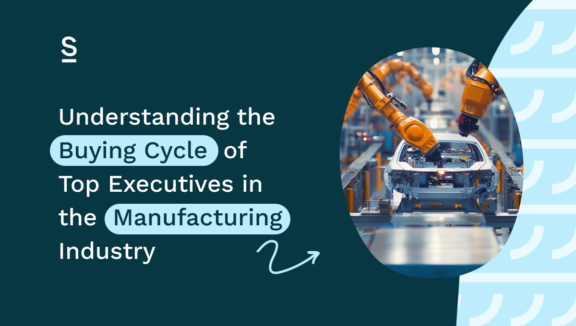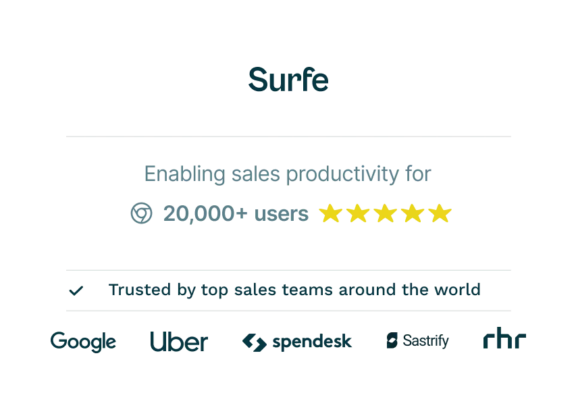Understanding the Buying Cycle of Top Executives in the Manufacturing Industry

As a sales professional tasked with selling to top executives in the manufacturing industry, we bet we know what superpower you’d ask for.
You’d want to turn into a mind-reading fly on the wall, right?
Flying into your prospect’s office, eavesdropping on their conversations with their teammates, and looking into their deepest thoughts to find out where they are in the buying cycle – sounds pretty good, right?
No, we promise we’re not a mind-reading fly on the wall ourselves (…or are we?). We just really, really understand how difficult it can be to manage manufacturing industry buying cycles. Aligning with capital investment timing and production and supply chain planning, handling multiple stakeholders…it’s a tall order.
That’s exactly why we’ve written this blog post – we want to help you out! Keep reading to discover:
- Identifying the Stages of the Buying Cycle
- Aligning Your Sales Strategy with Each Stage
- Adapting to Changing Buying Cycles
By the time you’ve finished reading, you’re going to feel well-equipped to handle your industry’s buying cycles. Doesn’t get better than that, does it?
Let’s get moving. Bzzzzz……
Overview of the Buying Cycle
First up: what’s the buying cycle? Simply put, it’s the journey your prospect sets out on from the moment they realize they have a problem. It ends when they’ve purchased your product, evaluated it, and (hopefully) decided they’re happy.
B2B sales cycles are notorious for being loooong – and the manufacturing industry’s buying cycles are no different. Why? Let’s find out:
Capital-intensive investments: as you well know, purchasing decisions in this industry often require significant capital investment. In other words: your deal sizes are likely to be big. This means your prospect will have to conduct a thorough ROI analysis, as well as secure budget approvals from higher-up executives or even the board.
Interconnected supply chains: supply chains are complicated – and top executives will have to carefully consider how a new solution will integrate with the existing
Multiple stakeholder involvement: whichever department you’re selling to, it’s likely that others will need to get involved to seal the deal. You might be looking at speaking to team members in engineering, operations, procurement, and finance for example.
Stages of the Buying Cycle
Buying cycles will look slightly different depending on what you’re selling, and to who. Broadly speaking, though, it’ll look a little like this:
Awareness: your prospect suddenly becomes aware that they have a big problem. They might try to understand what their solutions are – buy some software, hire someone, do nothing, and more might be on the table here.
Consideration: your prospect starts searching in earnest. That means starting to talk to providers and thinking about exactly what they need.
Evaluation: by now, conversations are starting to get specific. You’ll be speaking to different team members and sharing relevant content that shows why you’re the option to go with.
Decision: here, the prospect will decide between the final businesses on the shortlist – or, it might be a case of deciding what type of package to go for with just one provider.
Post-purchase: after the purchase, your CS team needs to get to work to prove your product’s value, with the ultimate aim of retaining them as a customer and possibly cross-selling later down the line.
Identifying the Stages of the Buying Cycle
It’s important to understand what stage of the buying cycle your prospect is at. Let’s take an example. Mike, salesperson number 1, doesn’t have a good grasp of buying cycles and where the prospect is at. Milly, salesperson number 2 who works at Mike’s competitor, does.
Mike hears from a prospect for the first time, and immediately starts sending over complex, highly technical content and jumps into calculating ROI as best as he can. Milly, on the other hand, is patient, and considers what the prospect needs – which at this early stage, is educational content and a request for a first meeting to find out how she can help.
The prospect is totally confused by Mike – they just wanted to get an idea of price and key functionality! – but totally won over by Milly. She expertly moves them to the next stage of the buying cycle and, some time later, closes the sale.
So, how can you be a Milly, not a Mike? Watch out for these key signals:
Awareness: the executive might start interacting with content, or going to events centered around production efficiency or reducing downtime (to give you just two examples). This shows they have a problem, and they’re looking at solving it.
Consideration: you might interact with a prospect for the first time here: they could request a whitepaper or ask for an introductory call.
Evaluation: here’s where the detailed analysis starts, and as a result, you’ll be sending case studies about similar manufacturing customers, speaking to other teams like engineering and operations, and running product demonstrations.
Decision: the final stretch! You might have some negotiations to iron out and start discussing what implementation looks like and how you’ll fit in with production schedules. At the same time, you’ll be seeking approval from key stakeholders – finance or procurement, for example.
Post-purchase evaluation: it’s been a while since the purchase has been made, and time for the prospect to see how their purchase is stacking up. They’ll request data, give feedback, and take the renewal or cross-sell conversation from there.
These are a lot of different signals: the good news is, you can automate finding a lot of them to keep your workflows quick and easy. Here’s how:
Tools and Techniques for Stage Identification
There are plenty of tools and techniques used to track the signals top executives in the manufacturing industry will display at different stages of the buying cycle. Here are our faves:
Your CRM: you can collect all the insights and data in the world, but if it’s all over the place and hard to track, you’re not going to find it very useful. Enter: your CRM, where all things prospects should be meticulously noted and tracked. Your CRM should integrate with other tools to make the process easy – or even automatic.
Content engagement: these insights can be found in your website data (for example, if a prospect is lingering over your pricing page) and your email data (they might open an email with a testimonial you shared multiple times). Or, they might even point blank ask for content to help them make a decision (we love it when that happens – no mind-reading required).
Buyer intent data: first-party buyer intent data comes from the prospect themselves – they might tell you what stage of the process they’re at (dream) or you might keep an eye on what they do on your website. Third-party buyer intent data comes from third-party providers like databases or industry publications.
Account-based marketing
We’re going to go out on a limb here and assume that you’re following some sort of account-based marketing (ABM) strategy. If not, we’d really recommend it!
ABM basically means sending over targeted content to grab your prospects’ attention, paying attention to what they do with it, and then using these insights to form the basis of outreach. It’s used for high-value accounts and sales cycles – which, as a sales exec in the manufacturing industry, we’re going to assume you’re working on.
ABM allows you to keep an eye on where your prospects are in the cycle – which in turn is going to help you nail your interactions with each and every one.
Aligning Your Sales Strategy with Each Stage
So, you know what stage your prospects are at – go you! But what you do with this information is even more important. Let’s dive in:
Awareness Stage
Your goal: you want to get your prospects interested in your product, and – even better – understanding of what problems you solve.
Strategies to get there: channels like LinkedIn or email newsletters are incredibly useful here. Use them to publish thought leadership content on industry trends and challenges to show you’re someone who can help them – and that they can trust.
Consideration Stage
Your goal: you need your solution to stand out against competitors and alternatives.
Strategies to get there: this means more targeted content. Pull out your most impressive case studies, share your whitepapers, and get your product-focused videos ready to go. At this point, you’ll want to speak to your prospect on a call – and maybe invite them to an exclusive event if that’s the type of thing you’re into.
Evaluation Stage
Your goal: you need to really hammer home the benefits of your solution and alleviate any anxieties, to make sure your prospect doesn’t go anywhere else.
Strategies to get there: at this point, you’ll be speaking to multiple stakeholders and need to manage each unique person in the process. This could mean conducting an ROI report for the CFO or introducing the CTO to your engineering team.
Decision Stage
Your goal: this one’s simple. Remove all barriers to your prospect signing on the dotted line.
Strategies to get there: your documentation should be clear, any final anxieties should be confidently handled, and all stakeholders should be firmly in line.
Post-purchase Stage
Your goal: you need to build the foundations of a long-term, positive relationship.
Strategies to get there: make sure you’re around for the onboarding process, and clearly communicate the terms of the handover. You’ll also want to give your CS team an introduction to the client and point them in the right direction of pain points to solve and cross-selling opportunities to explore.
Common Challenges and How to Overcome Them
Sales wouldn’t be sales without some twists and turns in the process, right? Here’s how to handle them like a pro:
Challenge 1: Extended Buying Cycles
28% of sales pros like you say lengthy sales cycles are the main reason prospects back out of sales deals. This means it’s your job to keep them as short and sweet as possible.
This may seem like a tall order in the manufacturing sector, where buying cycles are long due to significant investment, supply chain complications, and multiple stakeholder involvement.
To keep the momentum up, you want to be providing continuous value to everyone involved. Regular check-ins, tailored case studies, and meetings with all key stakeholders can help keep things on track.
Challenge 2: Multiple Decision-Makers
Buying groups are a common phenomenon in the manufacturing industry – after all, a lot of different departments will be impacted by the purchase, and everyone needs to be on board.
One of your most important tasks early on in the cycle is to make sure you’re speaking to everyone you need to – neglect this, and you could be faced with an unpleasant surprise at a bad moment. You’ll also need to make sure you’re appealing to each role, with specialized content relating to specific interests and anxieties.
Challenge 3: Regulatory and Compliance Considerations
We’re sure you’re familiar with the regulatory requirements of the manufacturing industry, like the OSHA safety standards for example. These are important (obvs) but can slow things down – to avoid this happening, make sure you’ve got content ready and waiting that shows exactly how your business is compliant and will keep your prospect well within industry regulations.
Case studies are also a good bet here, if you can find a current customer with the same regulatory and compliance constraints, you’re onto a winner.
Adapting to Changing Buying Cycles
Just to make things even more exciting, buying cycles aren’t static. Here’s how to stay adaptable:
Monitoring and Adjusting Your Approach
One of the joys of monitoring your approach is you can see what’s not working and rectify the problem quickly. If a prospect seems like they’re taking their sweet time, perhaps an additional case study or meeting will hurry things along?
Economic changes or new regulations can also be tricky here – the key is to think of them as opportunities rather than anything else. For example, a new regulation being introduced can be the perfect opportunity to reach out if your product can help manage the changes.
Leveraging Feedback for Continuous Improvement
Keep an ear out for feedback too. This could be direct – such as the prospect saying “Hey [name], I really loved this case study – it was so helpful!” or indirect – such as the prospect point blank ignoring all your messages.
Collecting feedback will help you improve your approach at the next stage of the cycle, and give you new approaches for other cycles, too.
Let’s Wrap It Up!
If you’ve made it this far, congratulations!
You’re now a certified* expert in the buying cycles of top executives in the manufacturing industry and should be feeling confident and ready to approach your next challenge. The better you can guide top manufacturing executives through the sales cycle, the faster your processes will get – and the better your performance will be as a result.
We’ll get you a solid gold fly swat as a reward*.
*to be clear, this is a joke. Sorry. Bzz.

The manufacturing industry won’t know what’s hit it.
But first, you need Surfe – how else are you going to find top executives to sell to? Hit the button below to find out what all the fuss is about, free of charge.


